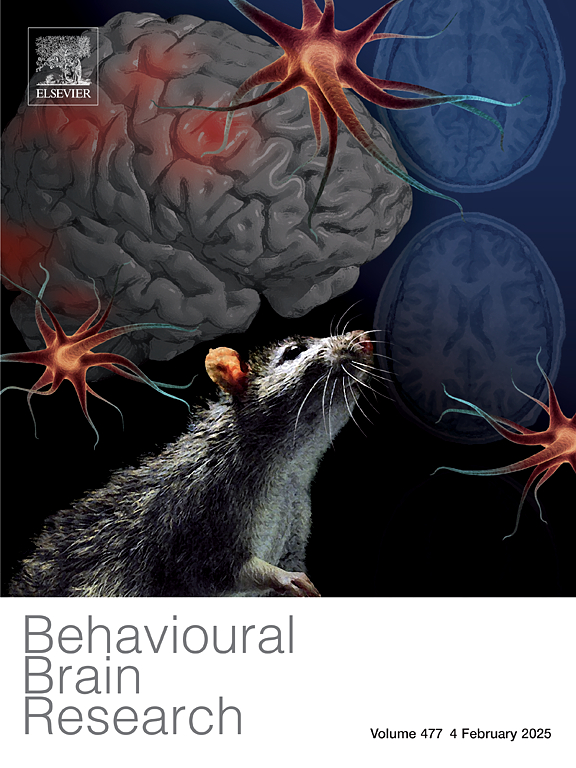甘丙肽3受体敲除小鼠的离散脑区酒精摄入后c-Fos表达的改变。
IF 2.6
3区 心理学
Q2 BEHAVIORAL SCIENCES
引用次数: 0
摘要
这项研究的目的是研究大脑中与甘丙氨酸(GAL),特别是GAL3受体(GAL3)在酒精摄入中的作用有关的区域。GAL3-KO小鼠在两瓶自由选择模式下表现出偏好酒精的表型。相比之下,在黑暗中饮酒(DID)模型中没有观察到乙醇摄入量的基因型差异,这突出了大脑GAL活动的不同参与取决于酒精消耗的实验模型。与野生型(WT)相比,在DID后,GAL3-KO小鼠的血液乙醇浓度降低了约10%。与饮水的WT小鼠相比,饮用乙醇的WT小鼠在前额叶皮层(PFC)的吻侧前边缘(PrL)和边缘下(IL)区域显著增加了c-Fos免疫反应(ir)神经元的数量,而海马背侧CA1区域(dHIP)的ir神经元数量减少,但乙醇在GAL3-KO小鼠中没有这些影响。与饮水WT小鼠相比,饮水GAL3-KO小鼠在吻侧PrL和dHIP CA3区域的c-Fos - ir神经元数量显著增加。在伏隔核(NAc)的核壳亚区、下丘脑室旁核(PVN)和杏仁核基底外侧,c-Fos细胞数量没有变化,GAL3基因型也没有参与。这些发现支持了gal3受体在酒精作用中的作用,并暗示了参与这种相互作用的离散大脑区域。本文章由计算机程序翻译,如有差异,请以英文原文为准。
Altered c-Fos expression following alcohol intake in discrete brain regions of galanin 3 receptor knockout mice
The aim of this study was to investigate the brain regions involved in the role of galanin (GAL) and specifically GAL3-receptors (GAL3) in alcohol intake. GAL3-KO mice displayed an alcohol-preferring phenotype in a two-bottle, free choice paradigm. In contrast, no genotype differences in ethanol intake were observed in a Drinking In the Dark (DID) model, highlighting the differential involvement of brain GAL activity depending on the experimental model of alcohol consumption. Blood ethanol concentrations were approximately 10 % lower in GAL3-KO mice compared to wildtype (WT) following DID. WT mice drinking ethanol had significantly increased numbers of c-Fos immunoreactive (ir) neurons in the rostral prelimbic (PrL) and infralimbic (IL) regions of the prefrontal cortex (PFC) and decreased numbers of ir neurons in the CA1 region of the dorsal hippocampus (dHIP) compared to water drinking WT littermates, but these effects of ethanol were absent in GAL3-KO mice. Water drinking GAL3-KO mice furthermore had significantly increased numbers of c-Fos ir neurons compared to water drinking WT mice in the rostral PrL as well as the CA3 region of the dHIP. In the core and shell subregions of the nucleus accumbens (NAc), or in the paraventricular nucleus of the hypothalamus (PVN) or basolateral amygdala, there were no changes in the number of c-Fos ir cells or any involvement of GAL3 genotype. These findings support a role of GAL3-receptors in the effects of alcohol and implicate discrete brain regions involved in this interaction.
求助全文
通过发布文献求助,成功后即可免费获取论文全文。
去求助
来源期刊

Behavioural Brain Research
医学-行为科学
CiteScore
5.60
自引率
0.00%
发文量
383
审稿时长
61 days
期刊介绍:
Behavioural Brain Research is an international, interdisciplinary journal dedicated to the publication of articles in the field of behavioural neuroscience, broadly defined. Contributions from the entire range of disciplines that comprise the neurosciences, behavioural sciences or cognitive sciences are appropriate, as long as the goal is to delineate the neural mechanisms underlying behaviour. Thus, studies may range from neurophysiological, neuroanatomical, neurochemical or neuropharmacological analysis of brain-behaviour relations, including the use of molecular genetic or behavioural genetic approaches, to studies that involve the use of brain imaging techniques, to neuroethological studies. Reports of original research, of major methodological advances, or of novel conceptual approaches are all encouraged. The journal will also consider critical reviews on selected topics.
 求助内容:
求助内容: 应助结果提醒方式:
应助结果提醒方式:


